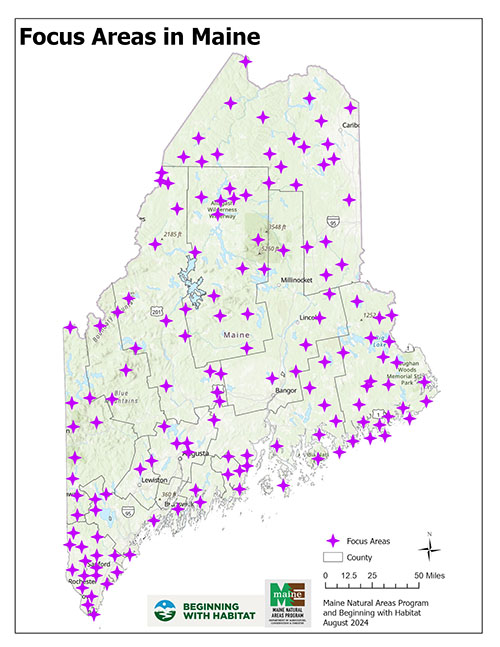DACF Home → Bureaus & Programs → Maine Natural Areas Program → Focus Areas
Focus Areas
Focus Area Descriptions
What are Focus Areas of Statewide Ecological Significance?
Beginning with Habitat (BwH) Focus Areas of Statewide Ecological Significance are areas to prioritize collaborative, non-regulatory conservation actions that benefit biodiversity in Maine.
Focus Areas were mapped to highlight natural areas of statewide biodiversity importance and contain high concentrations of at-risk species and habitats. Though Focus Areas occupy only about 11.5% of Maine's land area, collectively they include examples of over 85% of rare, threatened, and endangered plant and animal species and high-quality examples of all natural community types.
Voluntary and collaborative conservation actions for Focus Areas are diverse and may include purchasing land or conservation easements from willing sellers, wetland restoration, aquatic or terrestrial road crossing improvements, municipal planning, public outreach and education, invasive species management, and private landowner technical assistance and financial incentives.

How we Identify Focus Areas
Focus areas are identified by BwH partners and biologists from the Maine Department of Agriculture, Conservation and Forestry Natural Areas Program (DACF-MNAP), Maine Department of Inland Fisheries and Wildlife (MDIFW), Maine Department of Marine Resources (DMR), U.S. Fish and Wildlife Service (USFWS), The Nature Conservancy (TNC), Maine Audubon, and Maine Coast Heritage Trust (MCHT).
Generally, two or more of the following are present in a Focus Area:
- Globally rare plant or animal
- Three or more healthy populations of a rare plant species
- Any healthy population of a rare animal species
- Rare natural community
- Excellent example of a common natural community
- Good example of a common natural community and one or more high-value wildlife habitats
- Large undeveloped block and at least one of the following: a good example of a common natural community OR high-value wildlife habitat OR two or more healthy populations of a rare plant species
Find a Focus Area Near You
To date, collaborative efforts by state, federal, and conservation organization biologists have resulted in the designation of 140 Focus Areas of Statewide Ecological Significance.
View the full list and download fact sheets for most Focus Areas
Explore Focus Areas using Beginning with Habitat's Interactive Map Viewer
How to Use Focus Areas in Your Land Use Plans
A Focus Area in your region is a great starting place to direct conservation efforts. Consider the following approaches:
- Towns and land trusts can work together on referencing Focus Areas in comprehensive and open space plans and capitalize on opportunities for conservation within those areas
- Identify property owners whose lands host significant natural features and share and discuss voluntary conservation options ranging from habitat management actions to permanent land conservation
- Become familiar with the rare plants, animals, and habitats that occur within the FA and learn better how to manage their habitats for long-term conservation
- Educate landowners and the general public about significant natural areas within the FA and create support for local conservation initiatives to conserve them
- Cooperate with neighboring landowners and jurisdictions on a joint conservation plan
- Incorporate Focus Areas in grant applications
- Collaborate with state agencies for funding support
Are Other Areas Significant?
Focus Areas are considered ecologically significant at a statewide level, but they may not occur within the jurisdiction of every land trust or within the boundaries of every town.
Many local areas provide important wildlife and recreational values, even if they do not meet the designation criteria for statewide significance. Undeveloped habitat blocks outside of designated Focus Areas can provide essential stepping stones for species to move across the landscape and reach suitable habitat. These connections are increasingly important in the face of a changing climate, as species need to shift on the landscape to find favorable conditions. Conservation actions that protect and connect a network of undeveloped habitat blocks and Focus Areas can help Maine's plants and wildlife continue to thrive statewide.
If you have questions, please contact us. You can email us at maine.nap@maine.gov or phone (207) 287-8044.